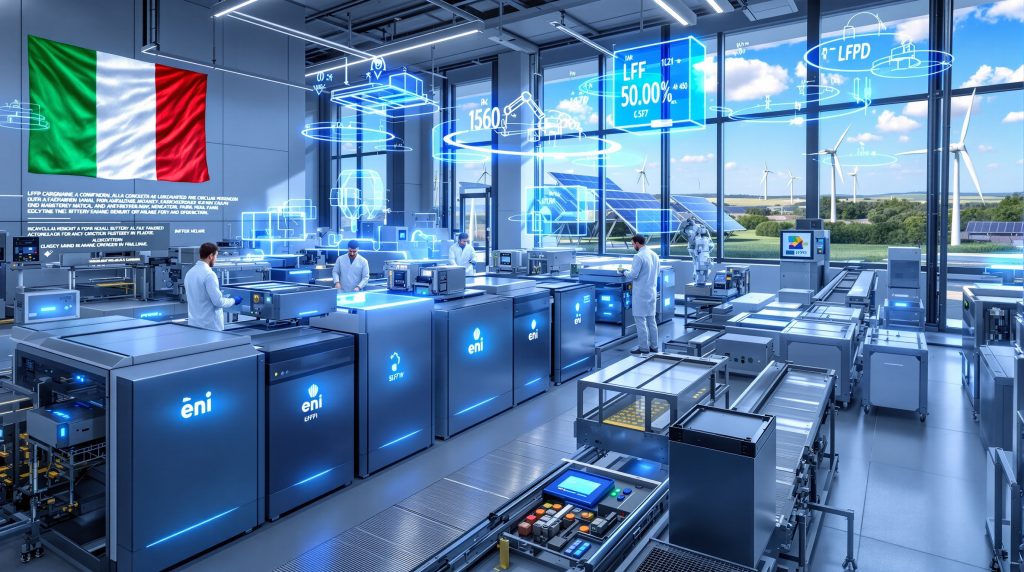Italy's LFP Battery Revolution: Inside Eni's Ambitious Manufacturing Hub
Italy is witnessing a significant transformation in its energy landscape with the formation of Eni Storage Systems, a strategic joint venture between energy giant Eni and Seri Industrial's subsidiary Fib. This partnership, in which Eni holds 50% plus one share, represents a bold move into the stationary battery storage sector, positioning Italy as a potential leader in European energy storage manufacturing.
The joint venture combines Eni's industrial scale and energy market expertise with Fib's battery technology capabilities, creating a powerful alliance focused on developing domestic battery production capacity. This collaboration marks a significant step in Europe's efforts to reduce dependency on Asian battery metals investment while building resilience in its clean energy supply chain.
What Makes the Brindisi Battery Factory Project Significant?
Production Scale and Technology Focus
The centerpiece of the joint venture's strategy is an ambitious 8 GWh-per-year manufacturing facility in Brindisi, southern Italy. This factory will specialize in lithium iron phosphate (LFP) batteries, primarily targeting stationary electricity storage applications. The production capacity represents one of the largest planned battery manufacturing initiatives in Europe dedicated to grid-scale storage solutions.
What distinguishes this project is its comprehensive approach to battery manufacturing. The Brindisi site will not only assemble batteries into complete storage systems but will also produce the critical LFP active cathode material—a component currently manufactured almost exclusively in Asia. This vertical integration strategy could significantly reduce supply chain vulnerabilities for European energy storage deployments.
Current Development Status
The project has entered its crucial permitting phase, with engineering activities already underway. According to statements from the joint venture partners, the project is currently progressing through engineering, economic, financial, and authorization phases, with these preliminary stages expected to conclude by the first quarter of 2026.
While specific timelines for the first batteries rolling off production lines remain undisclosed, the partners have indicated that once the preparatory phases are complete, the project will immediately transition to the executive implementation phase, suggesting a potential operational timeline in the 2026-2027 period.
How Will the Integrated Manufacturing Hub Operate?
The Brindisi-Teverola Connection
A key aspect of the Eni Storage Systems strategy is the creation of an integrated manufacturing hub connecting operations between Brindisi and the existing Teverola facility. The Teverola plant, located in Caserta, is currently Europe's only active production site for LFP cells, giving the joint venture a unique competitive advantage in the European market.
This two-site approach creates manufacturing synergies, with Brindisi focusing on LFP active cathode material production and battery assembly, while leveraging the established cell production capabilities at Teverola. The geographic proximity of these facilities in southern Italy creates logistical advantages and strengthens regional industrial development.
Circular Economy Integration
Beyond manufacturing, the Brindisi site will incorporate battery recycling breakthrough capabilities, embracing circular economy principles that are increasingly important in European industrial policy. This recycling component addresses the full lifecycle of battery products, potentially recovering valuable materials and reducing the environmental footprint of energy storage technologies.
The integration of recycling capabilities demonstrates the joint venture's forward-thinking approach to sustainability and resource efficiency, aligning with European Green Deal objectives and the broader transition toward more sustainable industrial practices.
What Market Opportunities is Eni Storage Systems Targeting?
European Stationary Storage Ambitions
The joint venture has set an ambitious target of capturing more than 10% of Europe's stationary battery market. This goal reflects the partners' confidence in both their manufacturing capabilities and the projected growth of energy storage demand across European markets.
Europe's energy storage sector is experiencing rapid expansion, driven by renewable energy transitions needs, grid stability requirements, and policy support mechanisms. Industry analysts project substantial growth in grid-scale battery installations across the continent, with cumulative capacity expected to increase significantly through 2030 and beyond.
Strategic Positioning in the Energy Transition
For Eni, this venture represents a strategic diversification into the clean energy value chain, complementing the company's broader energy transition initiatives. By establishing a foothold in battery manufacturing, Eni is positioning itself to benefit from the growing intersection between traditional energy markets and emerging storage technologies.
The focus on LFP chemistry is particularly strategic, as these batteries offer advantages in safety, longevity, and sustainability compared to some alternative lithium-ion formulations. While LFP batteries typically have lower energy density than nickel-manganese-cobalt (NMC) alternatives, this characteristic is less critical for stationary applications where space constraints are often less restrictive than in electric vehicles.
How Does This Project Impact European Energy Independence?
Reducing Import Dependency
Europe has recognized battery manufacturing as a strategic priority, with the European Battery Alliance and various policy initiatives aimed at building domestic production capacity. The Eni Storage Systems project directly addresses this priority by establishing local production of both battery cells and the critical cathode materials they require.
By producing LFP cathode active materials in Brindisi, the joint venture will reduce Europe's dependency on Asian imports for these essential components. This localization of the supply chain enhances energy security and reduces vulnerability to international supply disruptions or trade tensions.
Supporting Renewable Energy Integration
The stationary storage batteries produced at the Brindisi facility will play a crucial role in enabling greater renewable energy penetration in European electricity grids. As solar and wind generation continue to expand, large-scale battery storage systems become increasingly essential for balancing supply and demand, providing grid services, and ensuring system stability.
The 8 GWh annual production capacity could support the deployment of numerous grid-scale battery installations across Europe, contributing significantly to the continent's renewable energy integration capabilities and decarbonization objectives.
What Challenges Must the Project Overcome?
Competitive Global Landscape
Despite its ambitious scale, the Eni Storage Systems project faces significant competition in the global battery manufacturing sector. Chinese manufacturers have established dominant positions in LFP production, benefiting from economies of scale, established supply chains, and years of manufacturing experience.
European battery initiatives must navigate this competitive landscape while developing their own manufacturing expertise and scale. The joint venture's focus on vertical integration and circular economy principles may provide differentiation advantages, but cost competitiveness will remain a critical challenge.
Regulatory and Implementation Hurdles
The current permitting phase represents a crucial period for the project, as regulatory approvals and environmental assessments must be successfully navigated. European industrial projects often face complex regulatory requirements and potential community concerns that must be addressed through comprehensive stakeholder engagement.
Additionally, the technical challenges of establishing large-scale battery manufacturing operations should not be underestimated. Building manufacturing expertise, ensuring quality control, and optimizing production processes will require significant investment and organizational capability development.
What Does This Mean for Italy's Industrial Future?
Revitalizing Manufacturing Capabilities
The Brindisi battery factory represents a significant industrial investment in southern Italy, potentially creating new manufacturing jobs and revitalizing industrial capabilities in the region. This type of advanced manufacturing initiative aligns with broader European efforts to maintain and enhance industrial competitiveness in strategic sectors.
For Brindisi specifically, the project offers economic diversification opportunities, building on the area's industrial heritage while transitioning toward future-oriented clean energy technologies. The skills development and supply chain opportunities created could have multiplier effects throughout the regional economy.
Positioning in the European Battery Ecosystem
This initiative positions Italy more prominently within the emerging European battery ecosystem, complementing manufacturing developments in countries like Germany, Sweden, and France. A distributed manufacturing base across multiple European countries enhances the resilience of the continent's battery supply chain.
The project also demonstrates how traditional energy companies like Eni can leverage their industrial expertise and financial resources to accelerate the development of clean energy manufacturing capabilities, creating new business models that bridge conventional and renewable energy sectors.
What's the Outlook for LFP Battery Technology in Stationary Storage?
Technical Advantages for Grid Applications
LFP battery chemistry offers several characteristics that make it particularly suitable for stationary storage applications. These include excellent thermal stability and safety profiles, long cycle life, and reduced dependency on critical minerals like cobalt and nickel that face supply constraints and ethical sourcing challenges.
While LFP batteries typically have lower energy density than some alternatives, this limitation is less significant for grid-scale applications where footprint constraints are often less restrictive than in mobile applications like electric vehicles. The technology's durability and safety advantages often outweigh energy density considerations for many stationary use cases.
Market Trends and Future Developments
The stationary storage market has increasingly embraced LFP technology, with many major energy storage developers shifting toward this chemistry for grid-scale projects. This trend is driven by favorable economics, safety considerations, and supply chain advantages.
Future developments in LFP technology are likely to focus on incremental improvements in energy density, charge acceptance rates, and manufacturing efficiency rather than fundamental chemistry changes. The mature nature of LFP technology offers advantages in reliability and bankability for large-scale storage deployments.
Conclusion: Transforming Italy's Energy Storage Landscape
The Eni Storage Systems joint venture and its Brindisi battery factory project represent a significant step forward for Italy's position in the European energy storage manufacturing landscape. By creating an integrated production hub between Brindisi and Teverola, the partners aim to establish a competitive presence in the rapidly growing stationary storage market.
The ambitious 8 GWh production target, combined with the vertical integration of cathode material production and battery recycling capabilities, positions this initiative as one of Europe's most comprehensive approaches to battery manufacturing. As the project progresses through its permitting and engineering phases toward implementation, it could play a crucial role in advancing both Italy's industrial capabilities and Europe's energy transition objectives.
While challenges remain in terms of global competitiveness and implementation complexity, the strategic vision demonstrated by this joint venture highlights the growing recognition of energy storage manufacturing as a critical component of future industrial and energy strategies. The success of this initiative could provide a valuable template for similar projects across Europe as the continent works to build resilience and capability in clean energy supply chains.
FAQs About Eni's LFP Battery Factory
What is the production capacity of the planned Brindisi battery factory?
The facility aims to produce 8 GWh of LFP batteries annually, primarily for stationary electricity storage applications.
Who are the partners in the Eni Storage Systems joint venture?
The joint venture is formed between Eni (holding 50% plus one share) and Fib, a subsidiary of the Seri Industrial group.
When is the Brindisi factory expected to begin production?
While specific production start dates haven't been announced, the engineering and permitting phases are expected to be completed by Q1 2026, with implementation following immediately afterward.
What makes this project unique in the European context?
The project will not only manufacture batteries but also produce the LFP active cathode material currently made almost exclusively in Asia, creating a more complete domestic supply chain.
What market share does the joint venture aim to capture?
The partners have stated they aim to capture more than 10% of the European stationary battery market through their integrated manufacturing approach.
Further Exploration:
Readers interested in learning more about developments in European battery manufacturing can explore related educational content from Energy Storage News, which offers insights into various energy storage projects and lithium extraction innovation across Europe.
Want to Catch the Next Major Mineral Discovery Before the Market?
Discovery Alert's proprietary Discovery IQ model delivers instant notifications on significant ASX mineral discoveries, turning complex data into actionable investment insights that could lead to substantial returns. Explore why major discoveries can transform stock values by visiting Discovery Alert's dedicated discoveries page and position yourself ahead of the market.




